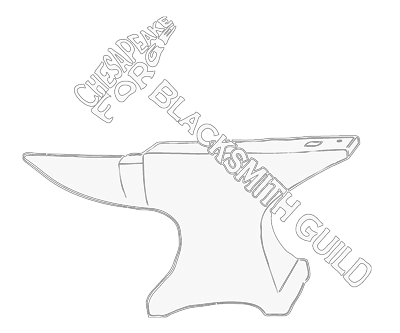Forge Safety
General
- Always wear safety glasses when forging.
- Please only work in our forge when two people are present.
Clothing Safety
- Wear cotton or wool clothing that will burn rather than melt to your skin.
- Wear leather high top boots with your pants over the top of your boots. I'd hate to image what it would be like to get a piece of burning coal in your shoe.
- Most experienced smiths don't wear a glove on their right (hammer) hand. This gives them better control over the hammer.
- If you wear a glove on your other hand, consider a cotton glove. If you heat up a leather glove, it will boil your hand inside.
Burn Safety
- While red- or white-hot steel will do more damage, you are more likely to be burned by accidentally picking up a piece of black-hot steel.
- Avoid burns by checking all metal with the back of your hand before picking it up.
- Place hot metal toward the back of the area between the forges, and let people know that it is hot.
Fire Safety
- Don't reach across the fire.
- Use a tool rest when needed. Make sure that your piece is not being held in place by the fire. If your piece is being held in place by the fire, as it burns down your piece will fly out, spraying you with hot coals.
- Smithies have been known to burn down, but not usually from the fire in the fire pot. Be careful about sparks that leave the fire.
- Keep combustible material in the smithy above the level of the fires, or better yet, out of the building.
- NEVER pour water directly into the middle of the fire. The temperature difference could cause the fire pot to crack.
- Break down your fire when finished by spreading the hot coals out next to the fire pot. Sprinkle with water to kill any active flames.
- Use only a moderate amount of water when putting out the fire. More will just create steam burns or a sauna.
- Before you lock up, check around for glowing embers.
Tool Safety
- Never hit a hammer with a hammer. You can create a deadly flying chip.
- Take the cutting hardy off of the anvil as soon as you are done cutting. I'd hate to imagine what would happen if your wrist hit the cutting edge while you were striking a blow.
- Inspect tools prior to use. If you find a broken tool, take it out of service by placing it in the broken tools box that is near the work bench.
- Stand up straight and keep your head up. Avoid bending your head over the work. You can get hit by the hammer bouncing off of the anvil.
- Use a hammer heavy enough to do the work but light enough for you to control.
- Avoid striking the anvil with the hammer. It can dent the anvil and the hammer might bounce back into your face.
- Get your shoulder involved when striking blows. Using just the wrist will give you carpal tunnel. Using just the elbow will give you tennis elbow.
- Use the brass head ("copper") hammer when cutting to avoid damaging the cut-off hardy.
- New hammers should be crowned (edge on face ground off) to avoid leaving squared corner hammer marks that are hard to remove. Sand the varnish off of the handle and coat with linseed oil to reduce the chance of getting a blister.
More Safety
- Refrain from forging galvanized steel. The zinc will become airborne and you will breathe it in. This can make you sick or even be fatal.
- Warn people prior to attempting to weld so that they can avoid the shower of sparks. Also, have the park guests step outside first.
- Avoid breathing coal dust. Wet down loose coal prior to sifting. Keep green coal wet. Wear a dust mask if desired. Use the vacuum cleaner.
- Watch which way your sparks are going when you are grinding.
- Look away from the arc when people are using the electric welder.

